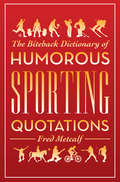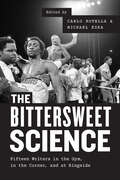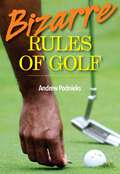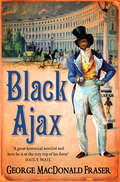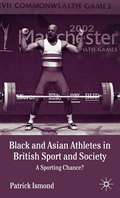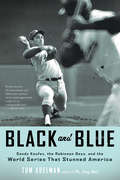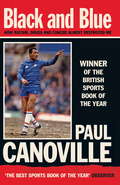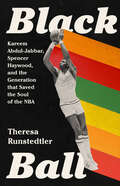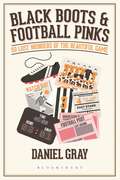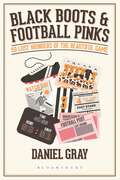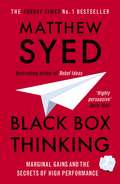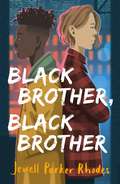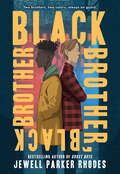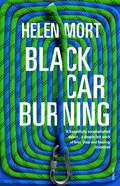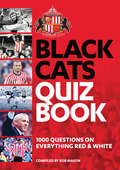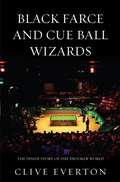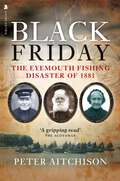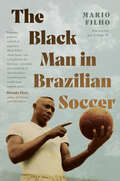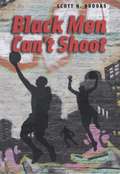- Table View
- List View
Biteback Dictionary of Humorous Sporting Quotations (Biteback Dictionaries Of Humorous Quotations Ser.)
by Fred MetcalfPlaying sport, watching it and commentating on it have all provoked endless mirth and some unforgettable rhetorical flourishes, the best and most enduring of which can be found here in the sparkling Biteback Dictionary of Humorous Sporting Quotations. Fred Metcalf has collected these laugh-out-loud funny contributions from the world of (mostly) athletic competition. Sardonic observations and unintended gaffes connected by a love (and sometimes hate) of anything from Cricket to Climbing and Fishing to Football make this book an essential companion for anyone with even a passing interest in the hobbies and games that we call 'sports'.
The Bittersweet Science: Fifteen Writers in the Gym, in the Corner, and at Ringside
by Carlo Rotella and Michael Ezra Michael EzraWeighing in with a balance of the visceral and the cerebral, boxing has attracted writers for millennia. Yet few of the writers drawn to it have truly known the sport—and most have never been in the ring. Moving beyond the typical sentimentality, romanticism, or cynicism common to writing on boxing, The Bittersweet Science is a collection of essays about boxing by contributors who are not only skilled writers but also have extensive firsthand experience at ringside and in the gym, the corner, and the ring itself. Editors Carlo Rotella and Michael Ezra have assembled a roster of fresh voices, ones that expand our understanding of the sport’s primal appeal. The contributors to The Bittersweet Science—journalists, fiction writers, fight people, and more—explore the fight world's many aspects, considering boxing as both craft and business, art form and subculture. From manager Charles Farrell’s unsentimental defense of fixing fights to former Golden Glover Sarah Deming’s complex profile of young Olympian Claressa Shields, this collection takes us right into the ring and makes us feel the stories of the people who are drawn to—or sometimes stuck in—the boxing world. We get close-up profiles of marquee attractions like Bernard Hopkins and Roy Jones Jr., as well as portraits of rising stars and compelling cornermen, along with first-person, hands-on accounts from fighters’ points of view. We are schooled in not only how to hit and be hit, but why and when to throw in the towel. We experience the intimate immediacy of ringside as well as the dim back rooms where the essentials come together. And we learn that for every champion there’s a regiment of journeymen, dabblers, and anglers for advantage, for every aspiring fighter, a veteran in painful decline. Collectively, the perspectives in The Bittersweet Science offer a powerful in-depth picture of boxing, bobbing and weaving through the desires, delusions, and dreams of boxers, fans, and the cast of managers, trainers, promoters, and hangers-on who make up life in and around the ring. Contributors: Robert Anasi, Brin-Jonathan Butler, Donovan Craig, Sarah Deming, Michael Ezra, Charles Farrell, Rafael Garcia, Gordon Marino, Louis Moore, Gary Lee Moser, Hamilton Nolan, Gabe Oppenheim, Carlo Rotella, Sam Sheridan, and Carl Weingarten.
The Bittersweet Science: Fifteen Writers in the Gym, in the Corner, and at Ringside
by Carlo Rotella and Michael Ezra Michael EzraWeighing in with a balance of the visceral and the cerebral, boxing has attracted writers for millennia. Yet few of the writers drawn to it have truly known the sport—and most have never been in the ring. Moving beyond the typical sentimentality, romanticism, or cynicism common to writing on boxing, The Bittersweet Science is a collection of essays about boxing by contributors who are not only skilled writers but also have extensive firsthand experience at ringside and in the gym, the corner, and the ring itself. Editors Carlo Rotella and Michael Ezra have assembled a roster of fresh voices, ones that expand our understanding of the sport’s primal appeal. The contributors to The Bittersweet Science—journalists, fiction writers, fight people, and more—explore the fight world's many aspects, considering boxing as both craft and business, art form and subculture. From manager Charles Farrell’s unsentimental defense of fixing fights to former Golden Glover Sarah Deming’s complex profile of young Olympian Claressa Shields, this collection takes us right into the ring and makes us feel the stories of the people who are drawn to—or sometimes stuck in—the boxing world. We get close-up profiles of marquee attractions like Bernard Hopkins and Roy Jones Jr., as well as portraits of rising stars and compelling cornermen, along with first-person, hands-on accounts from fighters’ points of view. We are schooled in not only how to hit and be hit, but why and when to throw in the towel. We experience the intimate immediacy of ringside as well as the dim back rooms where the essentials come together. And we learn that for every champion there’s a regiment of journeymen, dabblers, and anglers for advantage, for every aspiring fighter, a veteran in painful decline. Collectively, the perspectives in The Bittersweet Science offer a powerful in-depth picture of boxing, bobbing and weaving through the desires, delusions, and dreams of boxers, fans, and the cast of managers, trainers, promoters, and hangers-on who make up life in and around the ring. Contributors: Robert Anasi, Brin-Jonathan Butler, Donovan Craig, Sarah Deming, Michael Ezra, Charles Farrell, Rafael Garcia, Gordon Marino, Louis Moore, Gary Lee Moser, Hamilton Nolan, Gabe Oppenheim, Carlo Rotella, Sam Sheridan, and Carl Weingarten.
The Bittersweet Science: Fifteen Writers in the Gym, in the Corner, and at Ringside
by Carlo Rotella Michael EzraWeighing in with a balance of the visceral and the cerebral, boxing has attracted writers for millennia. Yet few of the writers drawn to it have truly known the sport—and most have never been in the ring. Moving beyond the typical sentimentality, romanticism, or cynicism common to writing on boxing, The Bittersweet Science is a collection of essays about boxing by contributors who are not only skilled writers but also have extensive firsthand experience at ringside and in the gym, the corner, and the ring itself. Editors Carlo Rotella and Michael Ezra have assembled a roster of fresh voices, ones that expand our understanding of the sport’s primal appeal. The contributors to The Bittersweet Science—journalists, fiction writers, fight people, and more—explore the fight world's many aspects, considering boxing as both craft and business, art form and subculture. From manager Charles Farrell’s unsentimental defense of fixing fights to former Golden Glover Sarah Deming’s complex profile of young Olympian Claressa Shields, this collection takes us right into the ring and makes us feel the stories of the people who are drawn to—or sometimes stuck in—the boxing world. We get close-up profiles of marquee attractions like Bernard Hopkins and Roy Jones Jr., as well as portraits of rising stars and compelling cornermen, along with first-person, hands-on accounts from fighters’ points of view. We are schooled in not only how to hit and be hit, but why and when to throw in the towel. We experience the intimate immediacy of ringside as well as the dim back rooms where the essentials come together. And we learn that for every champion there’s a regiment of journeymen, dabblers, and anglers for advantage, for every aspiring fighter, a veteran in painful decline. Collectively, the perspectives in The Bittersweet Science offer a powerful in-depth picture of boxing, bobbing and weaving through the desires, delusions, and dreams of boxers, fans, and the cast of managers, trainers, promoters, and hangers-on who make up life in and around the ring. Contributors: Robert Anasi, Brin-Jonathan Butler, Donovan Craig, Sarah Deming, Michael Ezra, Charles Farrell, Rafael Garcia, Gordon Marino, Louis Moore, Gary Lee Moser, Hamilton Nolan, Gabe Oppenheim, Carlo Rotella, Sam Sheridan, and Carl Weingarten.
The Bittersweet Science: Fifteen Writers in the Gym, in the Corner, and at Ringside
Weighing in with a balance of the visceral and the cerebral, boxing has attracted writers for millennia. Yet few of the writers drawn to it have truly known the sport—and most have never been in the ring. Moving beyond the typical sentimentality, romanticism, or cynicism common to writing on boxing, The Bittersweet Science is a collection of essays about boxing by contributors who are not only skilled writers but also have extensive firsthand experience at ringside and in the gym, the corner, and the ring itself. Editors Carlo Rotella and Michael Ezra have assembled a roster of fresh voices, ones that expand our understanding of the sport’s primal appeal. The contributors to The Bittersweet Science—journalists, fiction writers, fight people, and more—explore the fight world's many aspects, considering boxing as both craft and business, art form and subculture. From manager Charles Farrell’s unsentimental defense of fixing fights to former Golden Glover Sarah Deming’s complex profile of young Olympian Claressa Shields, this collection takes us right into the ring and makes us feel the stories of the people who are drawn to—or sometimes stuck in—the boxing world. We get close-up profiles of marquee attractions like Bernard Hopkins and Roy Jones Jr., as well as portraits of rising stars and compelling cornermen, along with first-person, hands-on accounts from fighters’ points of view. We are schooled in not only how to hit and be hit, but why and when to throw in the towel. We experience the intimate immediacy of ringside as well as the dim back rooms where the essentials come together. And we learn that for every champion there’s a regiment of journeymen, dabblers, and anglers for advantage, for every aspiring fighter, a veteran in painful decline. Collectively, the perspectives in The Bittersweet Science offer a powerful in-depth picture of boxing, bobbing and weaving through the desires, delusions, and dreams of boxers, fans, and the cast of managers, trainers, promoters, and hangers-on who make up life in and around the ring. Contributors: Robert Anasi, Brin-Jonathan Butler, Donovan Craig, Sarah Deming, Michael Ezra, Charles Farrell, Rafael Garcia, Gordon Marino, Louis Moore, Gary Lee Moser, Hamilton Nolan, Gabe Oppenheim, Carlo Rotella, Sam Sheridan, and Carl Weingarten.
Bizarre Rules of Golf
by Andrew PodnieksWhat happens if your golf ball becomes lodged in a tree and you can't get it down? What are youroptions if a ball lands behind a boulder or you want to try to play your ball out of a water hazard?What if you knock the ball off the tee while making a practise swing? For every situation in golf,there's a rule, and for every rule there's a bizarre case of occurrence or misunderstanding.Bizarre Rules of Golf examines more than 60 rules and situations-and their ramifications for golfersboth famous and obscure. From Tiger Woods putting for birdie and ending up in the water to BradFaxon hitting a nice approach shot only to watch a bird lift his ball off the green and plop it in thewater, the game's many rulings and interpretations of the rules book are probed and described inentertaining detail.Including the story of poor Pete Oakley. Competing at the 2012 Senior British Open, he was penalized twostrokes for losing his caddy. That's right-his caddy! (who also happens to be his wife) It's all here in Bizarre Rulesof Golf!
Black Ajax (Charnwood Large Print Ser.)
by George MacDonald FraserIn the spirit of Flashman and in the inimitable George MacDonald Fraser style comes a rousing story of prize fighting in the 19th century.
Black and Asian Athletes in British Sport and Society: A Sporting Chance?
by P. IsmondIn this innovative study, Patrick Ismond provides an analysis of the issue of racism within British sport. It presents a number of theoretical positions regarding race, racism and sport, before providing a background history of the involvement of minority ethnic communities. Much detailed primary research is used to inform interesting discussions concerning racism in sport and its relationship to ethnicity, identity and notions of Englishness and Britishness. The study also includes a valuable analysis of sexism in sport, and the discrimination suffered by minority ethnic sportswomen.
Black and Blue: Sandy Koufax, the Robinson Boys, and the World Series That Stunned America
by Tom AdelmanBaltimore 1966. Suffering through a summer of heated racial animosity, baseball fans look hungrily to the Orioles to bring new respect to their once-great city. Their young team of no-name kids and promising prospects appears to have been strengthened by the recent addition of veteran slugger Frank Robinson - but the former National League MVP is bad news (it is rumored), washed up and unreliable. To lay these rumors to rest, Robby must play harder than he's ever played before. In his first year in the league, against unfamiliar pitchers in new ballparks, he resoundingly proves his worth -- to his city, his team, and himself -- by delivering a Triple Crown performance. Aided by a hilarious and memorable cast of characters -- the gentlemanly southerner Brooks Robinson and the wickedly inventive prankster Moe Drabowsky, a pitching staff of unknown kids like Jim Palmer and Dave McNally, and a gargantuan yet nimble fielder called Boog" -- Frank Robinson delivers his new team to its first World Series. But before they take it all, the Orioles must unseat the reigning champion Los Angeles Dodgers. With America's cities in mounting turmoil, Los Angeles seems like another world altogether, a sunny land of surfers and movie stars. Comfortably dwelling in this higher plane is pitching ace Sandy Koufax, arguably the greatest lefthander in baseball history, behind whom the Dodgers have won two of the previous three World Series, replacing the Yankees as the sport's dominant team. Though battling agonizing arthritis throughout the season, the godlike Koufax has nonetheless persevered to win twenty-seven games in 1966, a personal best. Few outside Baltimore give the Orioles more than a fighting chance against such series veterans as Koufax, Don Drysdale, Maury Wills, Tommy Davis, and the rest. Experts are betting that the Dodgers can sweep it in four. "What transpires instead astonishes the nation, as the greatest pitching performance in World Series history is capped by a redemption beyond imagining." -- Book Jacket
Black and Blue: Sandy Koufax, the Robinson Boys, and the World Series That Stunned America
by Tom AdelmanBaltimore 1966. Suffering through a summer of heated racial animosity, baseball fans look hungrily to the Orioles to bring new respect to their once-great city. Their young team of no-name kids and promising prospects appears to have been strengthened by the recent addition of veteran slugger Frank Robinson - but the former National League MVP is bad news (it is rumored), washed up and unreliable. To lay these rumors to rest, Robby must play harder than he's ever played before. In his first year in the league, against unfamiliar pitchers in new ballparks, he resoundingly proves his worth -- to his city, his team, and himself -- by delivering a Triple Crown performance. Aided by a hilarious and memorable cast of characters -- the gentlemanly southerner Brooks Robinson and the wickedly inventive prankster Moe Drabowsky, a pitching staff of unknown kids like Jim Palmer and Dave McNally, and a gargantuan yet nimble fielder called Boog" -- Frank Robinson delivers his new team to its first World Series. But before they take it all, the Orioles must unseat the reigning champion Los Angeles Dodgers. With America's cities in mounting turmoil, Los Angeles seems like another world altogether, a sunny land of surfers and movie stars. Comfortably dwelling in this higher plane is pitching ace Sandy Koufax, arguably the greatest lefthander in baseball history, behind whom the Dodgers have won two of the previous three World Series, replacing the Yankees as the sport's dominant team. Though battling agonizing arthritis throughout the season, the godlike Koufax has nonetheless persevered to win twenty-seven games in 1966, a personal best. Few outside Baltimore give the Orioles more than a fighting chance against such series veterans as Koufax, Don Drysdale, Maury Wills, Tommy Davis, and the rest. Experts are betting that the Dodgers can sweep it in four. "What transpires instead astonishes the nation, as the greatest pitching performance in World Series history is capped by a redemption beyond imagining." -- Book Jacket
Black and Blue: How Racism, Drugs and Cancer Almost Destroyed Me
by Paul CanovillePaul Canovilles story is one of extreme racist bigotry, shattering career-ending injury, a decline into drug abuse, battles against cancer, family tragedy and a determination to beat the odds. Canoville was Chelsea's first black first-team player, making his debut in 1982. But as he warmed up on the touchline, his own supporters began chanting 'We don't want the nigger!' The racist bile continued whenever he played, but within a year he had won over the terraces with his explosive pace and skill. Canoville fell out with the Chelsea board and moved to Reading in 1986, where injury suddenly ended his career at the age of 24. This started a downward spiral including the death of his baby in his arms, two bouts of life-threatening lymph cancer, drug abuse and homelessness. But Canoville fought back. In this explosive and shocking story, Paul finally explains why, despite everything, he is more positive than ever and has remained a fervent Chelsea fan all his life. This is a story of hope - eventually - overcoming adversity.
Black Ball: Kareem Abdul-Jabbar, Spencer Haywood, and the Generation that Saved the Soul of the NBA
by Theresa RunstedtlerA vital narrative history of 1970s pro basketball, and the Black players who shaped the NBA Against a backdrop of ongoing resistance to racial desegregation and strident calls for Black Power, the NBA in the 1970s embodied the nation&’s imagined descent into disorder. A new generation of Black players entered the league then, among them Kareem Abdul-Jabbar and Spencer Haywood, and the press and public were quick to blame this cohort for the supposed decline of pro basketball, citing drugs, violence, and greed. Basketball became a symbol for post-civil rights America: the rules had changed, allowing more Black people onto the playing field, and now they were ruining everything. Enter Black Ball, a gripping history and corrective in which scholar Theresa Runstedtler expertly rewrites basketball&’s &“Dark Ages.&” Weaving together a deep knowledge of the game with incisive social analysis, Dr. Runstedtler argues that this much-maligned period was pivotal to the rise of the modern-day NBA. Black players introduced an improvisational style derived from the playground courts of their neighborhoods. They also challenged the team owners&’ autocratic power, garnering higher salaries and increased agency. Their skills, style, and savvy laid the foundation for the global popularity and profitability of the league we know today.
Black Boots and Football Pinks: 50 Lost Wonders of the Beautiful Game
by Daniel GrayA delightful exploration of the small details that make football great, from streakers to cup replays, paper tickets to floodlight failings, brawls, fanzines and cycling shorts, and of course, football pinks.Written with wit, nostalgia for the past, and packed with interesting facts to please any football fan.Entries include:1. Sharing the scores from elsewhere2. Referee occupations and hometowns3. Stripy, tartan and other turf patterns4. Black boots5. Late fitness tests6. Streakers7. Knowing the names of grounds8. Keepers in trousers and hats9. Local shirt and hoarding sponsors10. Football Pinks
Black Boots and Football Pinks: 50 Lost Wonders of the Beautiful Game
by Mr Daniel GrayA delightful exploration of the small details that make football great, from streakers to cup replays, paper tickets to floodlight failings, brawls, fanzines and cycling shorts, and of course, football pinks.Written with wit, nostalgia for the past, and packed with interesting facts to please any football fan.Entries include:1. Sharing the scores from elsewhere2. Referee occupations and hometowns3. Stripy, tartan and other turf patterns4. Black boots5. Late fitness tests6. Streakers7. Knowing the names of grounds8. Keepers in trousers and hats9. Local shirt and hoarding sponsors10. Football Pinks
Black Box Thinking: The Surprising Truth About Success
by Matthew SyedThe Sunday Times No.1 Bestseller From the Bestselling Author of BounceWhat links the Mercedes Formula One team with Google?What links Team Sky and the aviation industry?What connects James Dyson and David Beckham?They are all Black Box Thinkers.Black Box Thinking is a new approach to high performance, a means of finding an edge in a complex and fast-changing world. It is not just about sport, but has powerful implications for business and politics, as well as for parents and students. In other words, all of us.Drawing on a dizzying array of case studies and real-world examples, together with cutting-edge research on marginal gains, creativity and grit, Matthew Syed tells the inside story of how success really happens - and how we cannot grow unless we are prepared to learn from our mistakes.
Black Brother, Black Brother
by Jewell Parker RhodesA powerful coming-of-age story about two brothers - one who presents as white, the other as Black - and the ways they are forced to navigate a world that doesn't treat them equally.Donte wishes he were invisible. As one of the few black boys at his school, he feels as if he is constantly swimming in whiteness. Most of the students don't look like him. They don't like him either. Dubbed the 'Black Brother', Donte's teachers and classmates make it clear they wish he were more like his lighter skinned brother, Dre. When an incident with a white student leads to Donte's arrest and suspension, he's sure the only way to get even is to beat the student at the school's most valued game: fencing. With the help of a former Olympic fencer, Donte embarks on a journey to carve out a spot on the school's fencing team and to find a way to make people at school see past the colour of his skin to who he really is.From NYT bestselling author Jewell Parker Rhodes, another poignant and gripping story about how children and families face the complexities of race and racism in today's world.
Black Brother, Black Brother
by Jewell Parker RhodesFrom award-winning and bestselling author, Jewell Parker Rhodes comes a powerful coming-of-age story about two brothers, one who presents as white, the other as black, and the complex ways in which they are forced to navigate the world, all while training for a fencing competition. p.p1 {margin: 0.0px 0.0px 0.0px 0.0px; font: 13.0px Georgia} p.p2 {margin: 0.0px 0.0px 0.0px 0.0px; font: 13.0px Georgia; min-height: 15.0px} Framed. Bullied. Disliked. But I know I can still be the best. Sometimes, 12-year-old Donte wishes he were invisible. As one of the few black boys at Middlefield Prep, most of the students don't look like him. They don't like him either. Dubbing him "Black Brother," Donte's teachers and classmates make it clear they wish he were more like his lighter-skinned brother, Trey. When he's bullied and framed by the captain of the fencing team, "King" Alan, he's suspended from school and arrested for something he didn't do. Terrified, searching for a place where he belongs, Donte joins a local youth center and meets former Olympic fencer Arden Jones. With Arden's help, he begins training as a competitive fencer, setting his sights on taking down the fencing team captain, no matter what. As Donte hones his fencing skills and grows closer to achieving his goal, he learns the fight for justice is far from over. Now Donte must confront his bullies, racism, and the corrupt systems of power that led to his arrest. Powerful and emotionally gripping, Black Brother, Black Brother is a careful examination of the school-to-prison pipeline and follows one boy's fight against racism and his empowering path to finding his voice.
Black Car Burning
by Helen MortHow do we trust each other?Alexa is a young police community support officer whose world feels unstable. Her father is estranged and her girlfriend is increasingly distant. Their polyamorous relationship – which for years felt so natural – is starting to seem strained. As she patrols Sheffield she senses the rising tensions in its disparate communities and doubts her ability to keep the peace, to help, to change anything.Caron is pushing Alexa away and pushing herself ever harder. A climber, she fixates on a brutal route known as Black Car Burning and throws herself into a cycle of repetition and risk. Leigh, who works at a local gear shop, watches Caron climb and feels complicit.Meanwhile, an ex-police officer compulsively revisits the April day in 1989 that changed his life forever. Trapped in his memories of the disaster, he tracks the Hillsborough inquests, questioning everything.As the young women negotiate the streets of the city and its violent inheritance, the rock faces of Stanage and their relationships with each other, the urban and natural landscape watches over them, an ever-present witness. Black Car Burning is a brilliant debut novel of trust and trauma, fear and falling, from one of our best young writers.
The Black Cats Quiz Book: 1,000 Questions on everything Red and White
by Rob MasonAre you an SAFC brain-box? If so, then put that claim to the test in the Black Cats Quiz Book. If not, well you’ll be well on the way to being one after having a bit of fun testing yourself and your friends. There are 100 quizzes and 1000 questions on all aspects of the red and whites, compiled by Sunderland AFC club historian Rob Mason. Right up to date with questions on the 2017-18 season, the quizzes kick-off with the traditional number one, goalkeepers, and finish with Super Kev - and he was a good finisher. The Black Cats Quiz Book covers the entire history of the club, ancient and modern. Full of fascinating facts and featuring the all-time greats as well as those of fleeting moments of fame, the Black Cats Quiz Book is something for you to dip into every now and then - but the chances are, you won’t be able to put it down as you see just how much of an SAFC brain-box you really are.
Black Farce and Cue Ball Wizards: The Inside Story of the Snooker World
by Clive EvertonThroughout its chequered history, snooker has had more than its fair share of heroes and villains, champions and chumps, rascals and rip-off artists. In the last 20 years, every sleazy scandal imaginable has attached itself to this raffish sport: corruption, match fixing, bribery, sex, recreational drugs, performance-enhancing drugs, ballot rigging, fraud, theft, domestic violence, common-or-garden violence, paranoid politicking, dirty tricks - all against a background of inept petty tsars fixated on the pursuit, retention and abuse of power. In Black Farce and Cue Ball Wizards, Clive Everton recounts the glory and despair, the dreams and disillusion, and the treachery and greed that have characterised the game since it was invented as an innocent diversion by British Army officers in India in the nineteenth century. He tells the true and unexpurgated tale of snooker's transformation into a television success story second only to football and exposes how its potential has been shamefully squandered.
Black Friday: The Eyemouth Fishing Disaster of 1881
by Peter AitchisonBlack Friday is the astonishing true story of a coastal community that lost 189 men in a single afternoon. Britain’s worst fishing disaster decimated the coastal community of Eyemouth, yet is an almost forgotten part of the past. One hundred and thirty years on, this is the story of that storm, told through the accounts of fishermen at sea caught up in the maelstrom, of their families waiting anxiously for news, and of its historical context. At its heart is a gripping narrative of survival and high adventure when Eyemouth was the centre of a massive smuggling ring.Peter Aitchison does more than simply spin a good yarn: as a direct descendant, his account of how these fishermen plied their trade, led their lives and met their fate in the 1880s is an insightful and compelling read.
The Black Man in Brazilian Soccer (Latin America in Translation/en Traducción/em Tradução)
by Mario FilhoAt turns lyrical, ironic, and sympathetic, Mario Filho's chronicle of "the beautiful game" is a classic of Brazilian sports writing. Filho (1908–1966)—a famous Brazilian journalist after whom Rio's Maracana stadium is officially named—tells the Brazilian soccer story as a boundary-busting one of race relations, popular culture, and national identity. Now in English for the first time, the book highlights national debates about the inclusion of African-descended people in the body politic and situates early black footballers as key creators of Brazilian culture.When first introduced to Brazil by British expatriots at the end of the nineteenth century, the game was reserved for elites, excluding poor, working-class, and black Brazilians. Filho, drawing on lively in-depth interviews with coaches, players, and fans, points to the 1920s and 1930s as watershed decades when the gates cracked open. The poor players and players of color entered the game despite virulent discrimination. By the mid-1960s, Brazil had established itself as a global soccer powerhouse, winning two World Cups with the help of star Afro-Brazilians such as Pele and Garrincha. As a story of sport and racism in the world's most popular sport, this book could not be more relevant today.
Black Men Can't Shoot
by Scott N. BrooksThe myth of the natural black athlete is widespread, though it’s usually talked about only when a sports commentator or celebrity embarrasses himself by bringing it up in public. Those gaffes are swiftly decried as racist, but apart from their link to the long history of ugly racial stereotypes about black people—especially men—they are also harmful because they obscure very real, hard-fought accomplishments. As Black Men Can’t Shoot demonstrates, such successes on the basketball court don’t happen just because of natural gifts—instead, they grow out of the long, tough, and unpredictable process of becoming a known player. Scott Norman Brooks spent four years coaching summer league basketball in Philadelphia. And what he saw, heard, and felt working with the young black men on his team tells us much about how some kids are able to make the extraordinary journey from the ghetto to the NCAA. He tells the story of two young men, Jermaine and Ray, following them through their high school years and chronicling their breakthroughs and frustrations on the court as well as their troubles at home. Black Men Can’t Shoot is a moving coming-of-age story that counters the belief that basketball only exploits kids and lures them into following empty dreams—and shows us that by playing ball, some of these young black men have already begun their education even before they get to college.
Black Men Can't Shoot
by Scott N. BrooksThe myth of the natural black athlete is widespread, though it’s usually talked about only when a sports commentator or celebrity embarrasses himself by bringing it up in public. Those gaffes are swiftly decried as racist, but apart from their link to the long history of ugly racial stereotypes about black people—especially men—they are also harmful because they obscure very real, hard-fought accomplishments. As Black Men Can’t Shoot demonstrates, such successes on the basketball court don’t happen just because of natural gifts—instead, they grow out of the long, tough, and unpredictable process of becoming a known player. Scott Norman Brooks spent four years coaching summer league basketball in Philadelphia. And what he saw, heard, and felt working with the young black men on his team tells us much about how some kids are able to make the extraordinary journey from the ghetto to the NCAA. He tells the story of two young men, Jermaine and Ray, following them through their high school years and chronicling their breakthroughs and frustrations on the court as well as their troubles at home. Black Men Can’t Shoot is a moving coming-of-age story that counters the belief that basketball only exploits kids and lures them into following empty dreams—and shows us that by playing ball, some of these young black men have already begun their education even before they get to college.
Black Men Can't Shoot
by Scott N. BrooksThe myth of the natural black athlete is widespread, though it’s usually talked about only when a sports commentator or celebrity embarrasses himself by bringing it up in public. Those gaffes are swiftly decried as racist, but apart from their link to the long history of ugly racial stereotypes about black people—especially men—they are also harmful because they obscure very real, hard-fought accomplishments. As Black Men Can’t Shoot demonstrates, such successes on the basketball court don’t happen just because of natural gifts—instead, they grow out of the long, tough, and unpredictable process of becoming a known player. Scott Norman Brooks spent four years coaching summer league basketball in Philadelphia. And what he saw, heard, and felt working with the young black men on his team tells us much about how some kids are able to make the extraordinary journey from the ghetto to the NCAA. He tells the story of two young men, Jermaine and Ray, following them through their high school years and chronicling their breakthroughs and frustrations on the court as well as their troubles at home. Black Men Can’t Shoot is a moving coming-of-age story that counters the belief that basketball only exploits kids and lures them into following empty dreams—and shows us that by playing ball, some of these young black men have already begun their education even before they get to college.
